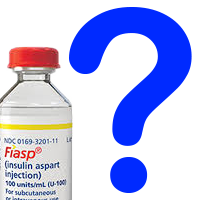I’ve been seeing some confused posts and questions on social media in the last week regarding Fiasp (the new “ultra-fast” insulin from Novo that’s now available in Australia through PBS prescriptions).
I would characterise Fiasp as essentially NovoRapid with the addition of nicotinamide (vitamin B3) to accelerate the absorption at the injection site.
Is Fiasp safe? Well it depends on who you’re asking, and also the context of the question!
There are multiple answers:
- No. No insulin is a “safe” drug: too much at the wrong time and you will die. But it’s an essential drug: not enough and you will die.
- Yes. Clinical trial data have shown that it’s roughly equivalent in safety to other fast-acting insulins.
- Maybe. Anecdotal evidence from users have indicated a variety of complicating issues. Note that this evidence does not seem to conflict with the data in the clinical trials.
MDI (injection) users
There doesn’t seem to be any data that indicates differences in dosing between Novorapid and Fiasp, nor issues with insulin resistance.
Keep in mind that for MDI there are occasional injections in changing locations around your body, and Fiasp will not be all your insulin. Usually about half your insulin comes from long-acting “basal” injections of a different insulin.
I would be comfortable using Fiasp for MDI. Obviously it will require re-learning how to time things to match the different foods we consume, but that’s normal.
Pump (infusion) users
The TGA-approved labels for Fiasp includes the use in pumps. Despite some rumours, Fiasp is approved for pump use.
The clinical trial data showed that Fiasp was “non-inferior” to NovoRapid. Although the trials were not specifically monitoring for these things, feedback from long-term use by actual users has indicated that some people have run into issues. These include:
- Irritation at infusion sites. Some users have to change cannula after 2 days instead of 3 as normal to avoid reductions in insulin absorption (which in severe cases could present similar to cannula occlusions). At the same time, many people have not encountered this.
- Eventual issues with increasing insulin resistance. After months some people have decided to revert to other insulins. But again many people have not encountered this.
I have seen no indication of Fiasp “blocking up” pumps, tubing, or cannulae. That was a very surprising rumour.
I am using Fiasp in a pump. Despite my hesitation going in to this based on the evidence, I have not yet decided it’s worth stopping!
Insulin sensitivity/resistance
While manufacturers claim that the dosing for NovoRapid, Humalog, and Apidra can be interchanged with no change in sensitivity/correction factors, that’s probably a simplification.
In my own testing of Apidra last year I found I needed about 3% more Apidra than Humalog. 3% is a fairly small difference, and was probably only noticeable to me because of the detailed data analysis provided by my closed-loop system. If I was using MDI I expect I probably would not have noticed the change. And especially not if I wasn’t using CGM.
With Fiasp so far I’m using 10% more (as discussed in yesterday’s article). That is getting to a stage that other people might notice it. But I think it’s likely that this effect may be a result of me using it for both basal and bolus insulin in a pump. That change might not appear in MDI use of Fiasp at all. For me it only appeared after 4 continuous days of pump use.
It’s conceivable that some MDI users might find that they have slightly different sensitivity to Fiasp as compared to other insulins, but it seems unlikely.
I have to stress that the above 3% and 10% figures were N=1 data. A very small sample set: just me!
My own experiment with Fiasp is continuing.
For further reading regarding pump use, see the discussion of Novo’s ONSET 5 trial data below.
Clinical trials
Novo did a bunch of safety/efficacy trials under the “ONSET” banner. Obviously they’ve been using these as supporting evidence to get their regulatory approval in various markets around the world. A quick search in June 2019 showed the following trials. If you click on the NCT trial IDs you’ll be taken to the trial data on the US clinicaltrials.gov website.
| ONSET 1 (NCT01831765) was a 1-year study of Fiasp vs NovoRapid combined with Levemir in T1D adults. |
| ONSET 2 (NCT01819129) was Fiasp vs NovoRapid combined with Lantus and metformin in T2D adults. |
| ONSET 3 (NCT01850615) was Fiasp with metformin for T2D adults. |
| ONSET 4 (NCT01999322) was a short-term (6-week) study with T1D adults using Fiasp in pumps. |
| ONSET 5 (NCT02825251) was a longer-term study of pump users. Tim Street’s discussion of it is worthwhile reading. |
| ONSET 7 (NCT02670915) was Fiasp vs NovoRapid when combined with Tresiba long-acting for kids with T1D. |
| ONSET 8 (NCT02500706) was the same thing for adults. |
| ONSET 9 (NCT03268005) is Fiasp vs NovoRapid in T2D adults. This is ongoing. |


David thank you for the discussion about Fiasp. As we know the organisations in Australia like TGA ,PBS and others are independent from other countries systems .Thank you again .